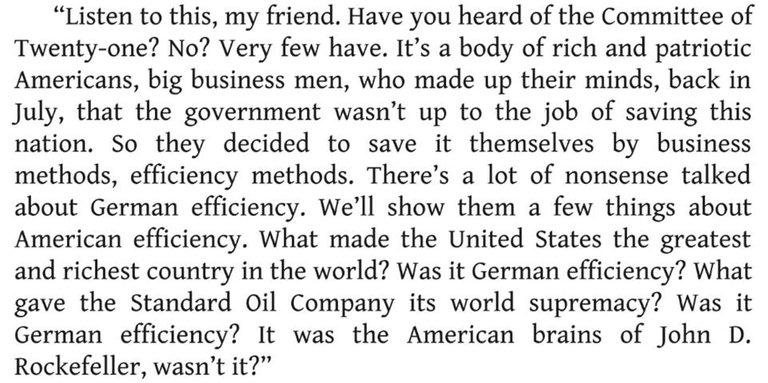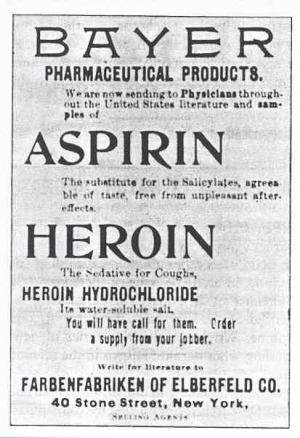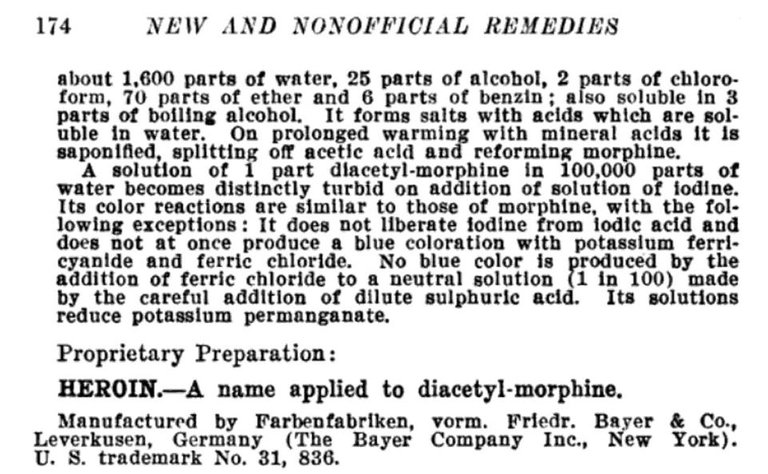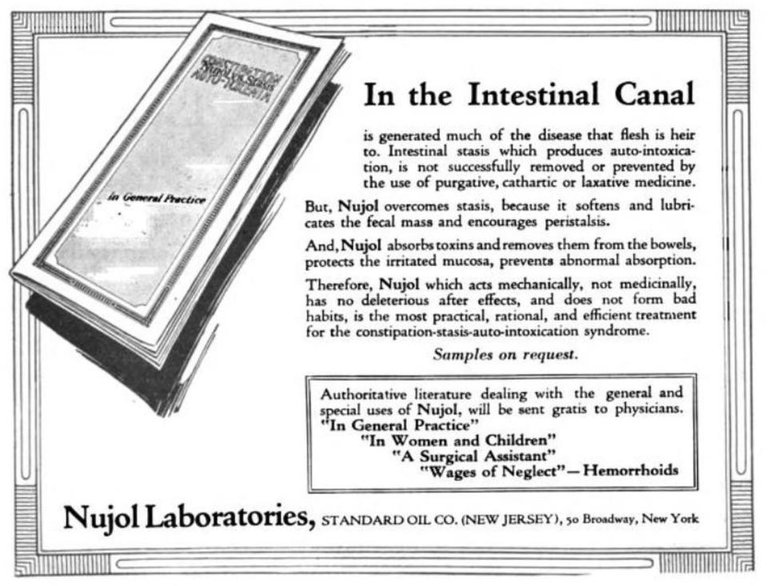The High Cost of Health Care: the Flexner Report (Part 3 - its German-pharmaceutical angle)
This is a series on the history of health care, exploring how and why health care costs in the US have risen beyond the levels a free market would normally bear. Other posts in this series:
Is health insurance sustainable?
Medical cartels an early response to natural medicine
The Flexner Report Part 1 -- its progressive efficient-monopoly angle
The Flexner Report Part 2 -- its discriminatory angle

The Flexner Report is pretty typical of an early progressive policy recommendation not only for its focus on efficiency and reducing competition but also for its praise of all things German. Early progressives saw much to appreciate and emulate in the “German model,” as Theodore Roosevelt assured Hugo Münsterberg in 1916: “I do not for one moment believe that the Americanism of today should be a mere submission to the American ideals... I have actively fought in favor of grafting on our social life, no less than our industrial life, many of the German ideals.” At the top of the list of German ideals that impressed progressives was German efficiency, which is still a thing.

Source: Derwen
Abraham Flexner, himself, was the son of German immigrants and had studied in both Berlin and Heidelberg. Two others associated with Flexner's report who also studied in Germany were Henry Pritchett and William Welch. Pritchett, who earned his PhD from the University of Munich,was the head of the Carnegie Foundation and the man who hired Flexner to produce the Report. William Welch, Flexner's fellow member of the Hopkins Circle, had studied in Germany in 1876 at Strassburg, Leipzig, and Breslau. (In trying to convince his father to fund the trip, Welch wrote, “If by absorbing a little German lore I can get a little start on a few thousand rivals and thereby reduce my competition to a few hundred more or less, it is a good point to tally.”) In 1910, William Welch would serve as president of the AMA, the association that commissioned the Flexner Report.
More than 35 years later, Welch contrasted Germany and the US in the Johns Hopkins Hospital Bulletin: “I was often asked in Germany how it is that no scientific work in medicine is done in this country, how it is that many good men who do well in Germany and show evident talent there are never heard of and never do any good work when they come back here. The answer is that there is no opportunity for, no appreciation of, no demand for that kind of work here. In Germany on the other hand every encouragement is held out to young men with taste for science.”
Abraham Flexner tipped his hat several times to Germany's education system in the Report, as he did here on page 43: “Doubtless in the near future, the problem will be still further simplified in the interest of the better training by increased scholarship and other endowments, as in Germany.” Flexner also briefly mentioned that the first laboratory of experimental pharmacology was that of Rudolph Buchheim, a German; that the first physiology laboratory was founded in Breslau, Germany; and that the first pathological institute was established by Rudolf Virchow in Berlin.
In the early 1900s, Germany also had a much lower number of doctors per capita than the US. And since one of the main goals of the AMA was to reduce the number of American doctors by reducing the number of medical school graduates, Flexner could justify this goal using a German precedent: “Professor Paulsen, describing in his book on the German Universities the increased importance of the medical profession, reports with some astonishment that 'the number of physicians has increased with great rapidity so that now there is, in Germany, one doctor for every 2000 souls, and in the large cities, one for every 1000.' What would the amazed philosopher have said had he known that in the entire United States there is already on the average one doctor for every 568 persons...”
But the progressive love for German ways expanded well beyond even that. Charles E. McClelland in his essay, “The German Model for American Medical Reform,” explains why Germany seemed so attractive to early progressives and to Flexner, in particular: “Here Continental school models, from Kindergarten to the German Realgymnasium, appealed as an alternative to the haphazard anarchy of a parochially-grown, decentralized American patchwork.” German effiency seemed to be the result of its tightly centralized organizations.

Source: Conquest of America, by Cleveland Moffett (1916), based on extracts
of the diary of London Times war correspondent James E. Langston
Perhaps the epitome of efficiency, though, was the American tycoon John D. Rockefeller, with his tight, centralized control over the various branches of Standard Oil. Rockefeller, like any good progressive, had been eliminating competition in his industry with business mergers since founding his company in 1870. And he personally inspired the merger that occurred in 1925 of several German pharmaceutical companies (including Bayer) into IG Farben.
Rockefeller's role in the production of the Flexner Report was mostly behind the scenes. The president of the AMA in 1908 (when its Council on Medical Education first commissioned the Flexner Report) was Joseph Decatur Bryant, John D. Rockefeller's personal physician. Rockefeller already knew William Welch and Simon Flexner personally, as Welch had become the first scientific director (1901) and Flexner the first laboratory director (1903) of the Rockefeller Institute (the research facility patterned after the German Koch Institute for Infectious Diseases). And it was Rockefeller who would later endow many of the Flexner-approved medical schools via his General Education Board. (By 1920, Abraham Flexner was the secretary of Rockefeller's General Education Board.)
Rockefeller's involvement in medical education philanthropy was first recommended by his advisor, Frederick T. Gates. In the late 1800s, Gates had read The Principles and Practice of Medicine, a book articulating the progressive views on medicine held by its author, William Osler. Osler was a friend of Abraham Flexner, as a fellow member of the Hopkins Circle along with William Welch and Simon Flexner. Osler had studied under Rudolf Virchow in Germany and, like Welch, was one of the founding doctors of Johns Hopkins School of Medicine, the school so praised and celebrated in the Flexner Report.
Gates shared his enthusiasm for Osler's work with Rockefeller and proposed that he create what became the Rockefeller Institute. Gates believed medical discoveries were stalled in the US because, unlike Germany's medical industry, the system here was scattered and disorganized. The progressive restructuring of medical education would follow as a logical continuation roughly 10 years later via the Flexner Report.
Rockefeller had another reason, however, to be actively involved in shaping the burgeoning medical industry: byproducts from crude oil were often used in the production of pharmaceuticals. These byproducts included solvents (petroleum benzene and petroleum ether) that were used in the preparation of drugs around the turn of the century. Additionally, refined liquid petroleum was an ingredient in at least two drugs manufactured by Parke Davis & Co.: Chloretone (1900) and Acetozone (1904). Petroleum byproducts were a lucrative way for Standard Oil to monetize the waste products of its normal operations.
The Chesebrough Manufacturing Company had been producing petroleum jelly since 1870. In 1881, Standard Oil bought a majority share of this company and became its primary supplier of petroleum. Interestingly, and in keeping with the pro-German theme of this post, Robert Chesebrough's product name Vaseline used the German word for water (wasser).
In the AMA's 1914 Annual Reprint of the Reports of the Council on Pharmacy and Chemistry of the AMA, researchers discussed how petroleum jelly could be used as a laxative. “During the past year or two,” it says on page 25 in the report (directly preceding another report on glycol-heroin), “liquid petrolatum has attracted considerable attention as a remedy in the treatment of intestinal stasis or chronic constipation.” One year later, Rockefeller's Standard Oil subsidiary, Stanco, introduced a product called Nujol, a petrolatum for the treatment of constipation.
(Please note that at this time, in 1915, Rockefeller no longer controlled the Standard Oil Trust; it had been broken up in 1911. But he did own a 25 percent share in each of the splintered companies including Standard Oil of New Jersey, the parent company of Stanco. Also, there are internet rumors that decades earlier John's father may have sold a similar petroleum byproduct that he called “Nujol” as a snake-oil cure for cancer, but I can't substantiate that rumor and don't have the time required to do so.)
Stanco's Nujol first appeared in one of the AMA's published reports in 1916 upon its rejection from a coveted list of drugs called the “NNR.” This stood for New and Nonofficial Remedies, a list put out by the AMA of approved “ethical” medicines.
Back then, an “ethical” drug was typically a prescription medicine that listed ingredients on its label and abstained from advertising directly to the public (though “ethical” drugs would advertise to druggists and doctors). Nujol had been rejected by the AMA's Council on Pharmacy and Chemistry in 1916 for not including the words “liquid petrolatum” in large-enough letters on its label and for being “advertised to the public under exaggerated and unwarranted claims.”
In contrast to the “ethical” drugs were “proprietary” medicines, which were generally over-the-counter (OTC) drugs that didn't list ingredients on their labels. Doctors often prescribed OTC drugs to their patients, too, but doctors clearly preferred the protocol of “ethical” medicines because it gave doctors control over access to those medicines and required paid visits to their offices.
Proprietary drugs were the “black sheep” of the pharma industry at that time. Many were hiding dangerous ingredients and making impossible claims... many, but not all. Other proprietary medicines were simply selling products consumers wanted because they were effective and affordable. However, the fact that proprietary drugs were often seen as “snake oil” allowed doctors and the AMA to use what seemed like a pretty legitimate argument to justify their desire for complete control over access to medicines.
It's important to realize all the repurcussions of requiring a doctor's prescription for any medicine, including simple pain killers like aspirin. First, the requirement would enrich the doctors writing those prescriptions. Second, the requirement would keep drug prices higher than a free market would normally bear because prescriptions are shifting demand expression from consumers to doctors and concentrating demand on only “approved” products. And third, the requirement would curtail the patient's freedom to make simple decisions about purchasing what are today OTC drugs. The patient is the one who loses in this scenario, while the doctors and drug makers are the ones who gain. Many saw this tradeoff as simply the price of having a safe, ethical medical industry, but because this series is about how the cost of healthcare has risen above what a free market would bear, it's important we not overlook this attempt by the AMA to increase drug prices while limiting access.
In an attempt to solidify such requirements, the AMA implemented a massive campaign to discredit proprietary medicines. It was a pretty easy task; the “secret” ingredient in many of these proprietary medicines was often some addictive or dangerous substance like cocaine or heroin. But don't forget, “ethical” preparations used these substances, too. If they were listed on the label, and their advertisements didn't make false claims, the AMA still considered them “ethical.”

The biggest weapon in the AMA's campaign was a series of reports called The Propaganda for Reform in Proprietary Medicines. The first appeared in 1905 and shared chemical analyses that “outed” various proprietary products. The reports also included criticisms related to false advertising, false labeling, ineffectiveness, or danger to the consumer. In contrast to The Propaganda, the AMA also published its NNR list or “New, Non-official Remedies” of drugs approved by the organization for their adherence to “ethical” drug protocols.
The 1914 NNR provides a good example of the type of drugs approved (though not necessarily recommended) by the AMA. That year, the NNR listed a total of 513 new drugs and foods. (These numbers are based on my own reading of a 1914 publication which took the better part of a day to comb through. The listing did not not always follow a standard pattern, so my count may not be exact.) Of the 513 drugs on the NNR, the US (263) and Germany (227) each produced about half, with a few other countries like England, France, and Russia contributing the remaining 23.
The top-producing “ethical” drug company in 1914 was the German company Bayer with 49 medicines listed in the NNR. Bayer is best known, of course, for its aspirin but it was also the first to synthesize and market heroin, which makes the NNR list on page 174 (below). A few of its other AMA-approved remedies were Piperazine (gout/uric acid prevention), Luminal (sleep aid), and Protargol (antiseptic for gonorrhea and conjunctivitis).

Bayer was a typical progressive company of its time, supporting the ideals of consolidation, efficiency, and reducing competition. One of Bayer's top executives, Carl Duisberg, visited New York in 1903 to deliver a speech at a meeting of the Chemical Society. (The meeting celebrated the 100th anniversary of the birth of Justus von Liebig, the father of organic chemistry who also happened to be German.) While in New York, Duisberg toured several large consolidated corporations, including Standard Oil, and returned to Germany convinced that Bayer should merge with other German drug and dye makers. “In 1903 [Duisberg] had laid down his ideas on cooperation between the large German dyestuff works,” H. Benninga explained in A History of Lactic Acid Making, “with the aim of cutting down on the very expensive development costs and capital investments by restricting competition and centralizing the purchasing and selling departments of companies.”
In his book, Earth Into Property, Anthony Hall describes Duisberg's desires to consolidate the German pharmaceutical industry in more detail: “[I]n 1903... Carl Duisberg travelled from Germany to New York to establish a US subsidiary of the Bayer corporation. [sic; while this may have been true, Bayer didn't establish a US subsidiary until 1913] While in the United States, he studied the workings of industrial cartels. These commercial monopolies maximized profits by minimizing competition. Duisberg devoted most of his attention to an evaluation of John D. Rockefeller's Standard Oil Company, an enterprise renowned for its ability to fix prices by destroying or ingesting competitors.”
Bayers' allegiance to the “ethical” drug protocol followed a further progressive belief that systems like pharmaceutical access should be centralized and controlled, not only for the financial benefit of the firms producing the drugs but also for the protection of the “common” man or woman who might be incapable of making the best decisions for themselves. The freedom to “self medicate” was frowned upon by control-hungry progressives and even today the term is perjorative.
But many of the “common” people back then rejected the push to be controlled by progressives. Judge Learned Hand, in his decision in the lawsuit over Bayer's trademark of the word “aspirin,” noted that this system of patient control was already being resisted: “The consumer, as both sides agree, had long before the autumn of 1915 very largely abandoned consultation with physicians and assumed the right to drug himself as his own prudence and moderation might prescribe.” (emphasis added)
Groups of proprietary drug manufacturers also resisted the push. In 1915, the editor of Standard Remedies, a pro-proprietary journal, saw the AMA's attempts to implement control over medicine as merely a way to funnel more business to doctors: “'Public health' does not demand formula disclosure. No one demands it except those who profess to believe that prepared medicines cannot survive formula publicity, hence would vanish, and leave the field to the dispensing doctor with his laboratory made medicaments.”
H.C. Fuller, the head of the Institute of Industrial Research's Drug Division in Washington, D.C., wrote in Standard Remedies in 1915, “[I]t would be fair to assume that within certain limits, mature, otherwise sane, persons have the right to select and to take their own medicines and that the resulting self-medication will not do more and may do less injury than the indiscriminate administrations of medicines by the really incompetent physician.”
Ultimately, the fight between ethical and proprietary drugs was a fight to raise drug prices, something the manufacturers supported (including many German drug/dye companies) and which is why proprietary medicines were referred to as the “poor man's medicine” on page 40, volume 28 of The Northwestern Druggist.
Of course, to mask the idea that doctors and pharmaceutical companies simply wanted to rake in more money, the argument was always put forth that such controls and restrictions were necessary for patient safety. And yet, the centralized systems for consumer safety implemented by the AMA and later the FDA have had a pathetic track record. Note the variety and severity of modern-day lawsuits against Bayer just in the last 20 years:
10,000 lawsuits for Yaz / Yasmin injury, death
520 lawsuits for Mirena IUD movement, injury, death
16,800 lawsuits for Essure injury, death
22,000 lawsuits for Xarelto bleeding injury, death
150 lawsuits for Trasylol increased risk of death
3,000 lawsuits for Baycol injury, death
780 lawsuits for Cipro / Avelox aortic injury
In 1909 as he began producing his Report, Abraham Flexner was clearly on board with the desire of the AMA, the “ethical” drug companies like Bayer, and even John D. Rockefeller, to keep the competition between drugs at a minimum, to remove “proprietary” drugs from the market, and to ensure doctor control over their access. On page 64 of the Report, Flexner quotes William Osler on the issue: “The traditions of the profession embody a 'pop-gun pharmacy, hitting now the malady and again the patient, the doctor himself not knowing which.' Besides, the practitioner is subjected... to the steady bombardment of the unscrupulous manufacturer.” By “unscrupulous” Flexner meant, of course, “proprietary” and, in a footnote, Flexner cites a worrying statistic: “On a basis of 5000 prescriptions examined, 47 per cent are for proprietary medicines.”
As a way to ensure that only physicians would choose among medicinal options, Flexner wanted to downplay the role of advertising: “Against bad example and persistent asseveration, only precise scientific concepts and a critical appreciation of the nature and limits of actual demonstration can protect the young physician.” (“asseveration” = positive claim) Rather than advertising, Flexner wanted doctors, themselves, to pick medicines based on empirical evidence: “The course in pharmacology need include, therefore, actual experimental determination by the student himself of the effect on animals of a relatively small number of carefully selected agents; demonstration of others by the instructor; and a critical survey of the rest by means of lectures and recitations.” Using empirical evidence as a benchmark isn't a bad idea, but it arrogantly ignores the right and ability of patients to employ that same critical decision-making based on the evidence of how various products satisfy a consumer's individual needs.
Flexner was suggesting, at the AMA's behest, that all decisions regarding medication be made by doctors. Considering how impressed he was by German educational methods, as well as the general feeling of progressives toward German ideals, and also considering that his future boss, John D. Rockefeller, would eventually own Bayer's US interests via a company called Sterling and would later invest heavily in Germany's drug conglomerate, IG Farben (of which Bayer's German arm was a part), it's not unreasonable to think that Flexner was willingly paving a way, in his report, for future doctors to funnel business to “ethical” German drug makers like Bayer.
(Note that in 1915, Bayer stopped following the “ethical” protocol because the company was losing market share to proprietary medicines that were advertising their products as “aspirin,” a term Bayer had trademarked in 1899. The company saw the only way to link its company name, Bayer, with its trademarked product name, aspirin, was to begin advertising and selling directly to the public.)




To listen to the audio version of this article click on the play image.

Brought to you by @tts. If you find it useful please consider upvoting this reply.
Hi @geke!
Your post was upvoted by @steem-ua, new Steem dApp, using UserAuthority for algorithmic post curation!
Your UA account score is currently 4.984 which ranks you at #1172 across all Steem accounts.
Your rank has not changed in the last three days.
In our last Algorithmic Curation Round, consisting of 94 contributions, your post is ranked at #12.
Evaluation of your UA score:
Feel free to join our @steem-ua Discord server